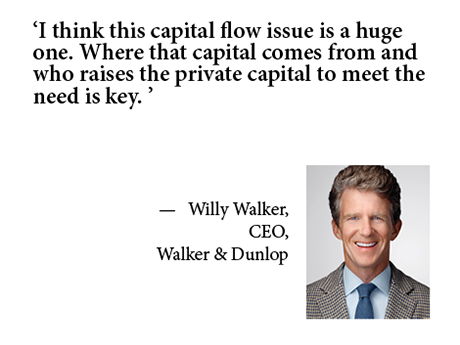On the April 12 episode of “The Most Insightful Hour in CRE” webcast, Willy Walker, CEO of Walker & Dunlop, spoke to renowned economist Dr. Peter Linneman, founding principal of Linneman Associates, about pressing issues facing the economy, pandemic repercussions, market predictions and much more.

Linneman Associates
The discussion began by diving into the economy and real estate market in its current state of flux, with many challenges facing both investors and developers. Walker outlines the unease created by the recent Silicon Valley Bank and Signature Bank crises. “One of the data points announced by the Fed is that since the crisis, bank lending in the United States has gone down by $110 billion over the two weeks since the Silicon Valley Bank collapse. Banks borrowed $160 billion in the two-week window prior. There’s a big drive toward liquidity; and yet there’s no new liquidity going out into the market.”
“There’s 4.4 trillion dollars of commercial real estate (CRE) loans outstanding across all lending sources — CMBS, life insurance companies, banks, etc.,” continues Walker. “About half of that is non-multifamily properties. Banks hold about 40 percent of total outstanding loans on commercial properties.” If banks were to pull back from holding 40 percent to a hypothetical 30 to 35 percent (and Walker cautions that this pullback could be more drastic, given what Dr. Linneman highlights in the economy), there is a situation where $200 to $400 billion worth of lending must come from sources other than banks.
“I think this capital flow issue is a huge one. Where that capital comes from and who raises the private capital to meet the need is key,” says Walker.
Linneman emphasized that despite a recent interest rate increase by the Federal Reserve, the current economy is not at risk of falling into a recession, and an annualized 1.2 percent inflation is not cause for alarm. He added, “It may not be our businesses that are adding jobs, but 68 percent of all industries in the United States are adding jobs.” This is in conjunction with the over 200,000 jobs that were created last month, according to the U.S. Bureau of Labor Statistics.
Linneman highlighted the impact of technology on the industry, noting that advances in areas such as data analytics and artificial intelligence are transforming the way real estate professionals do business. Technological solutions can enhance property management, customer experience and provide insights for optimizing business, all of which will further development and strengthen the relationship between consumers and the commercial real estate industry.
“The most valuable assets in real estate today are data and the ability to use it to make informed decisions,” said Linneman.
Some of these data-driven and analytical solutions that Linneman mentioned include the integration of property management software to streamline leasing, communication and maintenance tasks, as well as virtual and augmented reality immersive experiences for prospective buyers and tenants to view properties from anywhere in the world.
Linneman then switched his focus, sympathizing with those in the office sector, which has been gravely affected by COVID and by work-from-home culture. Linneman called upon business executives and leadership to take responsibility for a below-average return-to-office rate.
“CEOs, earn your pay — there’s a reason you’re getting paid the big money, right?” said Linneman. “You tell me privately that you believe the company is much more productive and profitable when people are there. Bring them back for your shareholders.”
In early February of this year, office occupancy across 10 major U.S. cities crossed 50.4 percent of pre-pandemic levels for the first time since early 2020. Inching its way back up, office occupancy levels have been held captive by profit margin considerations as well as comfort and accessibility concerns for employers and their employees.
Despite economic uncertainty and mixed messaging from corporate executives regarding the importance of a return to office, Linneman believes that the Fed will begin to reduce its rates this summer. He implored CRE investors to hold firm and weather the storm in spite of the hardships facing borrowers as a result of these rate hikes.
On the Horizon
A strong believer of an impending forward curve trajectory, Linneman suggests that buying an asset and putting a floating rate note (or “floater”) on it, will provide the opportunity to refinance it with a fixed-rate loan in two years at 100 to 150 basis points below current rates. Much of Linneman’s advice associated with his market predictions revolved around investors’ willingness and fortitude to hold onto their assets, despite the financial hardships that have occurred overwhelmingly as a result of the pandemic. Flexibility, adaptability and strategic thinking will be essential characteristics to successfully navigate the current landscape.
Speaking from the National Constitution Center in Philadelphia, Linneman called upon a nearby Philadelphia sports star to further illustrate his market predictions.
“If Joel Embiid had to go out of the game because he twisted his ankle — make hay while the sun shines. That is when you really have to try to run up some points if you are the opposition,” Linneman said. “It’s the same in real estate and investing in general. If you have capital and courage when others don’t — and you can hold — then you’re going to do well. It’s that simple.”
— By Sam Felton. Walker & Dunlop is a content partner of REBusinessOnline. For more articles from and news about Walker & Dunlop, click here.
Watch the April 12 webcast here.
Learn about upcoming Walker Webcast events here.


